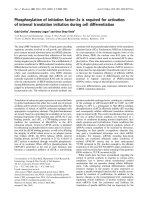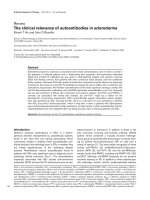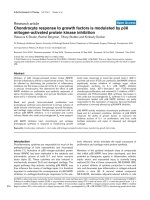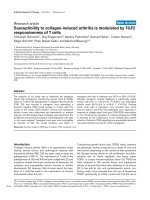Báo cáo y học: "Foot orthoses: how much customisation is necessary" pdf
Bạn đang xem bản rút gọn của tài liệu. Xem và tải ngay bản đầy đủ của tài liệu tại đây (162.86 KB, 3 trang )
BioMed Central
Page 1 of 3
(page number not for citation purposes)
Journal of Foot and Ankle Research
Open Access
Commentary
Foot orthoses: how much customisation is necessary?
Hylton B Menz
Address: Musculoskeletal Research Centre, Faculty of Health Sciences, La Trobe University, Bundoora, Victoria, Australia
Email: Hylton B Menz -
Abstract
The relative merit of customised versus prefabricated foot orthoses continues to be the subject of
passionate debate among foot health professionals. Although there is currently insufficient evidence
to reach definitive conclusions, a growing body of research literature suggests that prefabricated
foot orthoses may produce equivalent clinical outcomes to customised foot orthoses for some
conditions. Consensus guidelines for the prescription of customised foot orthoses need to be
developed so that the hypothesised benefits of these devices can be thoroughly evaluated.
Those outside the foot health professions would be justi-
fiably perplexed by the level of passion aroused by debates
regarding the prescription and manufacture of foot
orthoses. When all the professional turf wars, weekend
workshops and marketing spin are stripped away, all that
is left is a visually unremarkable piece of contoured ther-
moplastic placed inside the shoe. Despite technological
advances which have significantly altered approaches to
both the assessment of foot function and manufacture of
foot orthoses [1,2], the devices themselves have actually
changed surprisingly little over time. Nevertheless, it
would take a very brave individual to claim that foot
orthoses are nothing more than rebranded arch supports,
particularly when an entire industry is sustained by the
premise that modern foot orthoses are somehow differ-
ent.
Part of the explanation for the passion associated with
foot orthoses is that they do appear to be effective for a
wide range of conditions [3], and there can be few experi-
ences more satisfying to the foot health professional than
alleviating a patient's chronic pain with foot orthoses
when all other treatments have failed. In this context, cli-
nicians can perhaps be forgiven for believing that their
individual approach to the prescription and manufacture
of the orthoses was responsible for the positive outcome,
when in fact it is possible that a range of other approaches
could have worked equally well.
Broadly speaking, it could be argued that there are two
distinct approaches to the provision of foot orthoses –
customised versus prefabricated – although these
approaches are by no means mutually exclusive, as clini-
cians may interchangeably adopt either approach depend-
ing on individual patient needs and preferences.
Furthermore, the distinction between customised and pre-
fabricated orthoses has become somewhat blurred in
recent years, with several custom orthoses laboratories
offering generically contoured, semi-rigid orthoses in dif-
ferent sizes with a limited selection of shell modifications.
Nevertheless, the customised approach to foot orthosis
provision is based on two main premises: (i) that clinical
assessment can identify structural or functional deficits
that may be contributing to the development of the pre-
senting condition, and (ii) that the implementation of
various design features into the manufacture of a foot
orthosis (i.e. the "prescription") can selectively modify
aspects of foot function, thereby alleviating symptoms.
Proponents of prefabricated orthoses would argue that,
Published: 9 July 2009
Journal of Foot and Ankle Research 2009, 2:23 doi:10.1186/1757-1146-2-23
Received: 12 June 2009
Accepted: 9 July 2009
This article is available from: />© 2009 Menz; licensee BioMed Central Ltd.
This is an Open Access article distributed under the terms of the Creative Commons Attribution License ( />),
which permits unrestricted use, distribution, and reproduction in any medium, provided the original work is properly cited.
Journal of Foot and Ankle Research 2009, 2:23 />Page 2 of 3
(page number not for citation purposes)
with the exception of patients with marked morphologi-
cal or functional abnormalities, the provision of a generi-
cally-contoured, prefabricated orthosis will sufficiently
alter foot function to achieve equivalent clinical outcomes
in most situations.
Notwithstanding the surprisingly common clinical anec-
dote regarding patients getting better despite wearing their
orthoses upside down or in the wrong shoes, there is little
doubt that in order to be comfortable, let alone effective,
orthoses generally need to be an appropriate size and con-
tour to approximate the morphology of the plantar sur-
face of the foot. Where the two schools of thought start to
diverge, however, is in relation to cast and shell modifica-
tions – a cornucopia of skives, grooves, wedges and cut-
outs that some consider to be an essential component of
the prescription.
This apparent dichotomy is by no means restricted to foot
orthoses, as similar situations exist in many fields of
healthcare. For example, in the physiotherapeutic treat-
ment of low back pain, clinicians can be broadly catego-
rized as "splitters" (i.e. those who believe that there are a
wide range of anatomical causes of back pain which
require detailed clinical assessment and targeted treat-
ment) or "lumpers" (i.e. those who adopt the nomencla-
ture of "non-specific low back pain" and approach
treatment in a more generic, standardised manner) [4]. As
with foot orthoses, the relative merits of these two
approaches is the subject of passionate debate [5,6].
From a research evidence perspective, it is still too early to
definitively conclude which approach to the provision of
foot orthoses provides optimal clinical outcomes, how-
ever it is fair to say that the customised approach has expe-
rienced some setbacks in recent years. Not only have the
theoretical frameworks and clinical assessment proce-
dures commonly used to prescribe customised orthoses
been seriously questioned [7-9], but several randomised
controlled trials have shown prefabricated orthoses to
have similar efficacy to customised orthoses in the man-
agement of plantar fasciitis [10-12], and, more recently,
rheumatoid foot pain [13,14]. Although proponents of
customised orthoses will invariably argue that the
orthoses used in these trials were not optimally pre-
scribed, such an argument is difficult to sustain in the
absence of clearly defined, evidence-based prescription
guidelines. Furthermore, those seeking solace in the con-
clusions of the recent Cochrane review of customised foot
orthoses need to acknowledge that although there is good
evidence for the effectiveness of customised devices for
several conditions, the prescription protocols used in
these trials were by no means consistent, and few trials
used prefabricated orthoses as the comparator [15].
The June 2009 issue of Journal of Foot and Ankle Research
contained an interesting paper by Redmond and col-
leagues [16] which reported the results of a biomechanical
study comparing in-shoe plantar pressure patterns in 15
flat-footed participants wearing semi-rigid, customised
orthoses and semi-rigid, prefabricated orthoses. Although
both devices led to significant changes in pressure param-
eters compared to the shoe-only condition (primarily a
shift of load from the forefoot and rearfoot toward the
midfoot), there were no significant differences between
the two devices. While acknowledging that recommenda-
tions regarding cost-effectiveness should be based on data
from quality health economic studies, the authors never-
theless raised the issue of cost differences, stating that the
custom devices were 2.5 times more expensive than the
prefabricated devices, yet achieved very similar (biome-
chanical) outcomes.
The Redmond et al [16] study is not without its limita-
tions. First, the sample was relatively small, so the lack of
differences between the devices may have been due to
type II error (i.e.: failing to observe a difference when in
truth there is one). Secondly, the study was designed to
examine biomechanical differences between the devices,
rather than patient-oriented, clinical outcomes. Thirdly,
the prefabricated orthoses were manufactured from the
same materials as the customised devices (4 mm polypro-
pylene shell with 450 kg/m
2
ethyl vinyl acetate heel
posts), so the key differences being examined were the
contour and frontal plane "correction" of the two
orthoses. As such, the findings of this study cannot be gen-
eralised to other types of prefabricated orthoses that are
commonly manufactured from more compliant materi-
als. Finally, although the custom orthoses were "custom-
ised" in the sense that they were manufactured from a
neutral impression cast and were posted to the individ-
ual's neutral calcaneal stance position (i.e.: the commonly
employed "modified Root" technique), no additional cast
or shell modifications were used.
Despite these limitations, the discomfiting question
which arises from the Redmond et al [16] study it is this:
Is there any substantial benefit to be gained from the addi-
tional time and resources required to perform an array of
clinical measurements, take a plaster cast, write an indi-
vidual prescription and have the devices individually
manufactured, when selecting an appropriate prefabri-
cated orthosis and simply placing it in the shoe may
achieve very similar outcomes at far less cost? Neither the
Redmond study nor those that have preceded it fully
answer this question, but they do suggest that it is a ques-
tion worth asking. Indeed, the burden of proof now sits
squarely on the shoulders of proponents of customised
orthoses, who need to justify why this additional activity
and cost is necessary. This is a considerable challenge, as
Publish with Bio Med Central and every
scientist can read your work free of charge
"BioMed Central will be the most significant development for
disseminating the results of biomedical research in our lifetime."
Sir Paul Nurse, Cancer Research UK
Your research papers will be:
available free of charge to the entire biomedical community
peer reviewed and published immediately upon acceptance
cited in PubMed and archived on PubMed Central
yours — you keep the copyright
Submit your manuscript here:
/>BioMedcentral
Journal of Foot and Ankle Research 2009, 2:23 />Page 3 of 3
(page number not for citation purposes)
the essential first step to address this issue – the develop-
ment of consensus guidelines for prescribing customised
orthoses – will be difficult to achieve.
One way forward could be the application of the Delphi
technique [17]. Based on the assumption that group
judgements are more valid than individual judgements,
this method is used to assist in reaching consensus agree-
ment in areas where considerable variation of opinion
exists. Briefly, this approach involves a facilitator asking a
panel of experts a series of questions, the answers to which
are then fed back to the group, and any common or con-
flicting viewpoints are identified. This process is repeated
until opinions converge and a consensus is eventually
reached. The Delphi technique has been successfully
applied to solve problems in several fields of healthcare,
including seemingly intractable topics such as the defini-
tion and classification of low back pain [18]. The develop-
ment of consensus guidelines for the prescription of
custom foot orthoses using such a technique would be a
major step forward, and would provide a foundation
upon which customised foot orthoses could be evaluated
to the satisfaction of both researchers and clinicians.
Over time, further research may indeed reveal that there
are subgroups of patients and conditions that respond
more favourably to particular types of customised
orthoses compared to prefabricated orthoses. However,
given that many clinicians report high levels of success
with orthotic therapy despite adopting a wide range of
techniques, it is also possible that the individual prescrip-
tion may not substantially contribute to the eventual out-
come in many situations. While this proposition may be
an affront to the more ardent proponents of customised
foot orthoses, the average clinician may breathe a sigh of
relief at the prospect of not having to perform an array of
clinical measurements, take plaster casts, or fill in long
orthotic prescription forms ever again. Nevertheless, we
probably have a long way to go before the question posed
by the title of this commentary can be satisfactorily
answered.
Competing interests
The author declares that they have no competing interests.
References
1. Grumbine N: Computer generated orthoses. A review. Clin
Podiatr Med Surg 1993, 10:377-391.
2. Orlin M, McPoil T: Plantar pressure assessment. Phys Ther 2000,
80:399-409.
3. Landorf K, Keenan A-M: Efficacy of foot orthoses – what does
the literature tell us? J Am Podiatr Med Assoc 2000, 90:149-158.
4. Turk DC: The potential of treatment matching for subgroups
of patients with chronic pain: Lumping versus splitting. Clin J
Pain 2005, 21:44-55.
5. McCarthy CJ, Cairns MC: Why is the recent research regarding
non-specific pain so non-specific? Man Ther 2005, 10:239-241.
6. Wand BM, O'Connell NE: Chronic non-specific low back pain –
sub-groups or a single mechanism? BMC Musculoskelet Disord
2008, 9:11.
7. McPoil TG, Hunt GC: Evaluation and management of foot and
ankle disorders: present problems and future directions. J
Orthop Sports Phys Ther 1995, 21:381-388.
8. Payne CB: The past, present and future of podiatric biome-
chanics. J Am Podiatr Med Assoc. 1998, 88(2):53-63.
9. Nester CJ: Lessons from dynamic cadaver and invasive bone
pin studies: do we know how the foot really moves during
gait? J Foot Ankle Res 2009, 2:18.
10. Pfeffer G, Bacchetti P, Deland J, Lewis A, Anderson R, Davis W, Alva-
rez R, Brodsky J, Cooper P, Frey C, Herrick R, Myerson M, Sammarco
J, Janecki C, Ross S, Bowman M, Smith R: Comparison of custom
and prefabricated orthoses in the initial treatment of proxi-
mal plantar fasciitis. Foot Ankle Int 1999, 20:214-221.
11. Martin JE, Hosch JC, Goforth WP, Murff RT, Lynch DM, Odom RD:
Mechanical treatment of plantar fasciitis. A prospective
study. J Am Podiatr Med Assoc 2001, 91:55-62.
12. Landorf KB, Keenan AM, Herbert RD: Effectiveness of foot
orthoses to treat plantar fasciitis: a randomized trial.
Arch
Intern Med 2006, 166:1305-1310.
13. Novak P, Burger H, Tomsic M, Marincek C, Vidmar G: Influence of
foot orthoses on plantar pressures, foot pain and walking
ability of rheumatoid arthritis patients-a randomised con-
trolled study. Disabil Rehabil 2009, 31:638-645.
14. Cho NS, Hwang JH, Chang HJ, Koh EM, Park HS: Randomized con-
trolled trial for clinical effects of varying types of insoles
combined with specialized shoes in patients with rheuma-
toid arthritis of the foot. Clin Rehabil 2009, 23:512-521.
15. Hawke F, Burns J, Radford JA, du Toit V: Custom-made foot
orthoses for the treatment of foot pain. Cochrane Database Syst
Rev. 2008, 16(3):CD006801.
16. Redmond AC, Keenan AM, Landorf KB: Contoured, prefabri-
cated foot orthoses demonstrate comparable mechanical
properties to contoured, customised foot orthoses: a plantar
pressure study. J Foot Ankle Res. 2009, 2(1):20.
17. Jones J, Hunter D: Consensus methods for medical and health
services research. BMJ 1995, 311:376-380.
18. Dionne CE, Dunn KM, Croft PR, Nachemson AL, Buchbinder R,
Walker BF, Wyatt M, Cassidy JD, Rossignol M, Leboeuf-Yde C,
Hartvigsen J, Leino-Arjas P, Latza U, Reis S, Gil Del Real MT, Kovacs
FM, Oberg B, Cedraschi C, Bouter LM, Koes BW, Picavet HS, van
Tulder MW, Burton K, Foster NE, Macfarlane GJ, Thomas E, Under-
wood M, Waddell G, Shekelle P, Volinn E, Von Korff M: A consensus
approach toward the standardization of back pain definitions
for use in prevalence studies. Spine 2008, 33:95-103.









